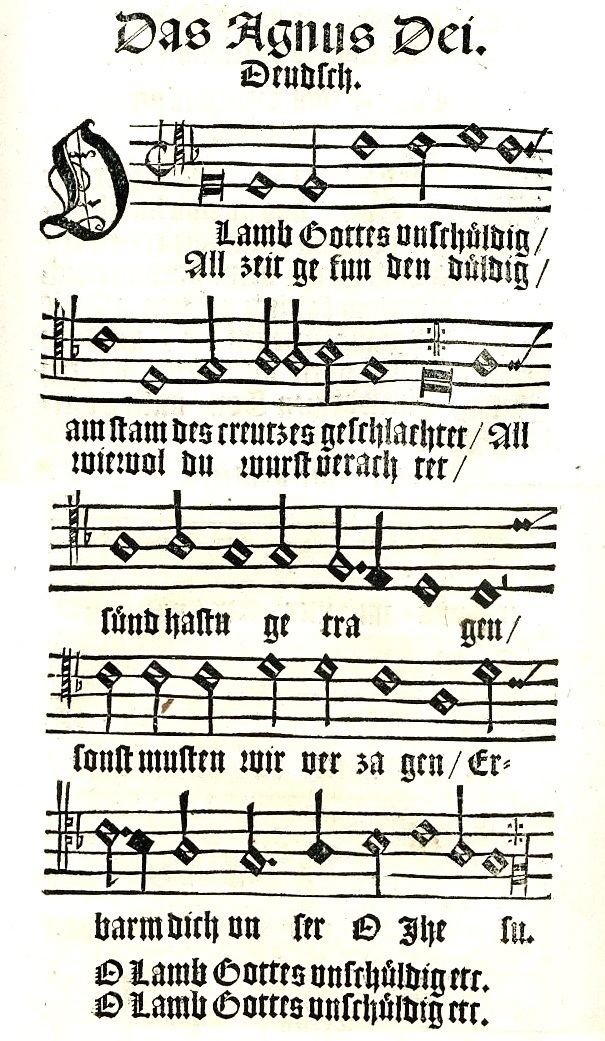Based on "Agnus Dei" | Language German Published 1531 (1531) | |
 | ||
Melody by Decius on an older model | ||
"O Lamm Gottes, unschuldig" (O Lamb of God, innocent) is an early Lutheran hymn, with text and melody attributed to Nikolaus Decius. Originally intended as a German hymn instead of the Latin Agnus Dei, it was used rather as a hymn for Passiontide. In both meanings, the hymn has often been set to music, prominantly as the cantus firmus in the opening chorus of Bach's St Matthew Passion. It is included in most German hymnals, and was translated, for example by Catherine Winkworth.
Contents
History
Until the 18th century, the hymn "O Lamm Gottes, unschuldig" was printed in hymnals without mentioning an author. Philipp Julius Rehtmeyer presented in his historical Braunschweigischen Kirchen-Historie a Latin report from 1600, which called Decius as the author of text and melody of ""O Lamm Gottes, unschuldig" and "Allein Gott in der Höh sei Ehr". A medieval melody may have been the model for the tune. The creation of hymns by Decius is dated 1522/23, in the early Reformation, before Martin Luther's first hymns.
The song was first printed in Low German in Joachim Slüter's Geystlyke leder in Rostock in 1531. The first print in High German appeared in a hymnal in Leipzig in 1539. It was distributed in German-speaking regions. The melody appeared with the text first in Johann Spangenbergs hymnal Kirchengesenge Deudtsch, published in Magdeburg in 1545, but it had appeared in a slightly different version a few years earlier in a Strasbourg hymnal.
Text
Like in the Latin model, the Lamb of God is called three times, twice asking for mercy, the third time for peace. The text is given with the translation of Catherine Winkworth, published in 1863 as No. 46 in her Chorale Book for England.
Hymnals
In all early prints, "O Lamm Gottes, unschuldig" is titled Das Agnus Dei Deutsch (The Agnus Dei in German), indicating that it was supposed to take the position of the Agnus Dei during the Abendmahl (communion). This function was soon taken by Luther's "Christe, du Lamm Gottes", while "O Lamm Gottes, unschuldig", which adds the memory of Christ's Passion, was used as a hymn for Passiontide. In some regions, it was the conclusion of Good Friday services until the 19th century.
The hymn was included in the Evangelisches Kirchengesangbuch (EKG) of 1950 as a Passion song, EKG 55, with two slightly different melodies, called northern ("norddeutsche") and southern ("süddeutsche") version.
The hymn appeared in 1616 first in a Catholic hymnal, in Paderborn, then in the Groß Catholisch Gesangbuch by David Gregor Corner. It was included in 1938 as "O du Lamm Gottes unschuldig" in the collection Kirchenlied as the only Agnus Dei song.
An ecumenical group, Arbeitsgemeinschaft für ökumenisches Liedgut, worked in 1973 on a common version, which appeared in the Catholic Gotteslob in 1975 and in the Protestant Evangelisches Gesangbuch (EG 190.1). In the current Gotteslob the song is GL 203. In all these hymnals, the song was again grouped as an Agnus Dei song.
Melody and musical settings
Johann Sebastian Bach used the hymn as a cantus firmus in the opening movement Kommt, ihr Töchter, helft mir klagen of his St Matthew Passion. He wrote it, without words, in red ink in the middle between the first choir on top of the page and the second at the bottom. Bach also composed chorale preludes on the hymn, one part of the Great Eighteen Chorale Preludes as BWV 656, and BWV 1085, found in the Neumeister Collection. He wrote a four-part setting, BWV 401.
Max Reger composed a chorale prelude as No. 32 of his 52 Chorale Preludes, Op. 67 in 1902. Sigfrid Karg-Elert included a setting as No. 20 of his 66 Chorale improvisations for organ, published in 1909.
